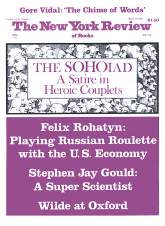To the Editors:
When Oscar Wilde was released from Reading Gaol in May 1897 he brought with him a 50,000-word manuscript: the text of a mainly accusatory letter, undated, but addressed from “H.M. Prison, Reading” to “Dear Bosie” (Lord Alfred Douglas), and signed “Your affectionate friend, Oscar Wilde.” This gargantuan epistle has been generally known as De Profundis, a title given to the drastically abbreviated text first published in 1905 by Robert Ross.
In 1897 Ross was instructed by Wilde to make four typed copies (two complete, two partial) before sending the original MS to Douglas, then living near Paris. Presumably without Wilde’s knowledge, Ross deleted about a thousand words from his “complete” typescripts; and, with or without Wilde’s permission, kept the MS. He later claimed to have sent one of the “complete” typescripts to Douglas, but Douglas always denied having received it.
Up to now, the only documents known to have survived from these transactions have been Wilde’s MS (since 1909 in the British Museum) and one of the “complete” typescripts. But in the summer of 1982 another, and much shorter, typescript has come to light. Its owner, British-born Mrs. Alison Augustin, of Menlo Park, California, believes it to have been in her family’s possession for about seventy years; but she has no idea how or from whom it was acquired.
A close examination of this fascinating document (some 30,000 words long) has convinced me that it was prepared in 1897 by Ross, who intended to send it to Douglas. (Whether he did or not is another question.) The text corresponds very closely to the portions deleted by Ross from Wilde’s original text for the version published in 1905 as De Profundis. That text, which reads like a philosophical essay, omits all reference to Douglas. The Augustin Typescript, on the other hand, consists almost entirely of recriminations aimed at Douglas and his father, the vindictive Marquess of Queensberry. (Both halves of Wilde’s original text were published, in the first truly complete and accurate text, by Sir Rupert Hart-Davis, in his 1962 edition of Wilde’s correspondence.)
Richard Ellmann, who is currently working on a critical biography of Wilde, and H. Montgomery Hyde have both expressed an interest in the Augustin Typescript, while of course reserving judgment on its significance until the textual evidence has been assembled in readable form—something I hope to do in the near future. The typescript may help to clarify Ross’s editing of Wilde and Ross’s attitudes toward Lord Alfred Douglas.
In the meantime, New York Review readers can perhaps be of some assistance. I have yet to discover the whereabouts of the surviving “complete” typescript of 1897; and I’d like to know whether that document, like the Augustin Typescript, is on 8″ * 13″ paper, bearing the watermark “Remington Sales Bond.” Finally, can anyone supply information about the Remington paper firm and about that particular variety of paper?
Robert D. Pepper
San Jose State University
San Jose, California 95192
This Issue
March 29, 1984



